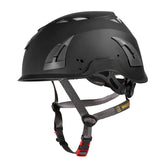Ladders have a bit of a bad reputation.
As an industry, we now place intense scrutiny on the health and safety of those working on construction and scaffolding sites. Great effort has gone in to developing equipment and delivering education that will help tradespersons carry out their work at height safely.
However, falls from height are still one of the leading causes of workplace fatalities and injuries. Of increasing concern are falls from height following unauthorised access to ladders and work areas by the public, especially children, often resulting in major injuries.
These risks have led many to believe that ladders and stepladders are inherently dangerous. Yet often, the problem isn’t the ladder itself. In fact, according to Health and Safety Executive (HSE)[1], ladders can be a sensible and practical option for those lower risk, shorter duration tasks.
What is important is ensuring you and your team:
- are using the right type of ladder for the job
- have sufficient understanding regarding using ladders safely
- deploy the right preventative measures so only those with the right skills and needs are able to use a ladder
When should I choose a ladder?
Before deciding whether or not to take that ladder out of the van, a risk assessment should be undertaken. A ladder may not be the best option, and the first step in ladder safety is to avoid use if possible.
That said, if certain conditions are met and a risk assessment concludes that an increased level of fall protection is not warranted because of either low risk, or short duration of use, then utilising a ladder is perfectly acceptable.
Leach’s top tip - ladders should only ever be used when it has been deemed safe to do so. We recommend ensuring the ladder is placed on level and stable ground, and where practical to do so the ladder is safely secured.
Who should use the ladder?
It’s really important that only those with the required competencies and training are allowed to use a ladder at work. That training can be done on the job, it’s just important that it happens.
Under no circumstances should untrained members of staff or the public be allowed to use ladders on site.
How to prevent unauthorised use of ladders
Once we’ve established a ladder is the best option, it's critical to ensure it is used safely, and those who are unauthorised to use a ladder are prevented from doing so. A simple (but effective) method of achieving this is of course to removing the ladder when not in use, but there are additional options.
According to HSE, a ladder guard is an effective and safe prevention technique. A ladder guard is a sturdy, metal plate that hooks over and padlocks onto several rungs of the ladder to deny access to the higher reaches of a scaffold. Only those authorised personnel with key access can then use the ladder. HSE have listed these guidelines to follow when choosing the deploy ladder guards.
This Ladder guard from Leach’s complies perfectly with HSE’s guidelines and includes a chain and padlock, acting as the ideal deterrent against unauthorised use of site ladders.
Why regular inspections are crucial
Almost a third of all reported falls from height are caused by ladders and step ladders. But often, these incidents could’ve been prevented if a rigorous ladder inspection process was in place.
In line with current regulations, at Leach’s we recommend ladders are inspected for physical defects or faults by an authorised user before each use. A simple way of ensuring this process is regularly undertaken is by deploying a LadderTag kit.
LadderTag kits and inserts present the perfect solution to reducing ladder-based incidents on site and improving your inspection processes. They deliver high visibility and clearly highlight if a ladder should not be used.
Prevent falls from the top
When ladders are in use on a scaffold, it's essential to have preventative measures in place that stops workers from falling through the hole the ladder enters through.
Leach's Ladder Trap Door or Ladder Access Trap Door prevents falls and helps you remain health and safety compliant. The Ladder Access Safety Hatch Trap Door is secured to the boards and has an aluminium door to give additional strength.
If you’re looking for support to ensure the safe use of ladders on site, get in touch with Leach’s friendly team who can advise on the best solutions.


















